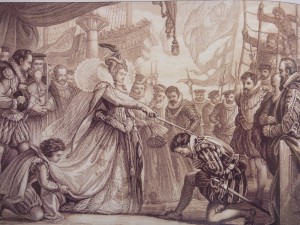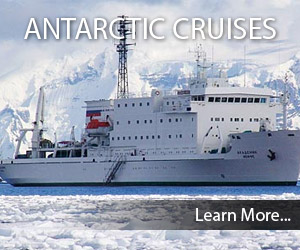04 Sir Francis Drake
In 1572, the brilliant English navigator Francis Drake (c.1540–96) led an expedition to raid Spanish possessions in Panama. Here he had his first glimpse of the Pacific and formed the intention “to sail once in an English ship in that sea.” In December 1577 he sailed with five vessels with the goal of mapping the coast of the South Land that was believed to lie below the Pacific Ocean. He reached the entrance of the Strait of Magellan in August 1578. Drake’s chaplain, Francis Fletcher, reported that the vessels sailed through a “crooked strete,” with mountainous land on either side … “with such tops and spires into the aire and so rare a height as they may well be accounted amongst the wonders of the world …”
When he arrived at the Pacific Ocean in September, Drake did not experience the same benign conditions as Magellan. Rather, an “intolerable tempest” drove the 100-tonne Golden Hind southeast as far as 57°S. So, by chance, and traveling backward, Drake discovered the place where the Atlantic and Pacific oceans “meete in most large and free scope” in what is now the Drake Passage. It was clear that Tierra del Fuego was an island, and that the tip of the Southern Continent must lie even further to the south.
In 1579 the Low Countries broke away from Spanish rule. It was the birth of a new seafaring nation, and the Dutch East India Company, founded in 1602, was to have a profound influence on exploration and trade for the next 200 years. Paradoxically, the next major development in exploration of the Southern Ocean resulted from an act of rebellion against the company. By the early seventeenth century it was illegal for ships other than the Company’s to pass through the Strait of Magellan, so when the wealthy Amsterdam merchant Isaac le Maire organized a private expedition, he decided to seek out the southern seaway of which Drake spoke.
So in 1615 two vessels, the Eendracht and the Hoorn, commanded by Wilhelm and Jan Schouten respectively, set sail for Patagonia under the overall command of le Maire’s son, Jacob. Fire destroyed the Hoorn during the voyage but on 29 January 1616 the Eendracht became the first ship to round Cape Horn, which Wilhelm Schouten named Kaap Hoorn after his birthplace in northern Holland. One of the world’s most notorious nautical landmarks was now on the shipping maps.
By 1642, the Dutch colony of Batavia was well established and ships of the Dutch East India Company had explored part of the west coast of Australia. But no one knew whether Australia was part of the legendary Great South Land, so Abel Janszoon Tasman sailed from Batavia to explore the Indian and Pacific Oceans. Over 10 months he reached about 49°S and proceeded north to discover Tasmania, which he described as “not cultivated but growing wild by the will of God.” He continued to New Zealand, which he assumed was the western shore of the southern continent, and returned to Batavia having circumnavigated the continent of Australia without ever seeing it. The Great South Land had shrunk again. Over the following century various national expeditions discovered land that they thought was the southern continent but turned out to be small sub-Antarctic islands.
James Cook of the Royal Navy undertook the next major exploration of Antarctic waters.
author: David McGonigal
Thinking of travelling to Antarctica?
Visit our Antarctic travel guide.
Early Explorers
- 01 First speculations
- 02 The Age of Exploration
- 03 Ferdinand Magellan
- 04 Sir Francis Drake
- 05a James Cook (1768-1771)
- 05b James Cook (1772-75)
- 05c James Cook The Final Voyage
- 06 Thaddeus von Bellingshausen (1819-21)
- 07 Who first saw Antarctica?
- 08 Who first set foot on Antarctica?
- 09 James Weddell (1822-24)
- 10 Sealers and whalers
- 10a Biscoe and the Enderby Brothers
- 11 Jules Sébastien César Dumont d’Urville (1837-40)
- 12 Charles Wilkes (1838-42)
- 13 James Clark Ross (1839-43)
- 14 The Challenger Expedition (1872-76)
- 15 Adrien de Gerlache (1897-1899)
- 15 Henryk Johan Bull (1894-95)
- 16 Carsten Borchgrevink (1898-1900)





 Email Newsletter
Email Newsletter